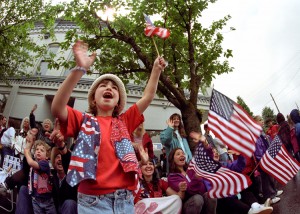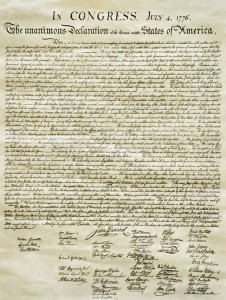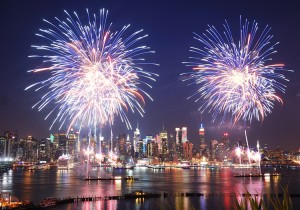July 4: USA 2.41
Tuesday, July 4th, 2017July 4, 2017
Today, the Fourth of July, is Independence Day in the United States. The day marks the nation’s birthday, July 4, 1776, when delegates to the Second Continental Congress, meeting in Philadelphia, adopted the Declaration of Independence. That day 241 years ago was one of the biggest—if not the biggest—in U.S. history. What other days, given without a year, conjure up a concrete, unmistakably American event? Perhaps two—December 7 and September 11—but those days are not days of celebration. July 4, however, is a day of celebration, and Americans celebrate it in unique fashion with a full menu of picnics or cookouts and fireworks, with popular side dishes of baseball, fairs, parades, and parties. Somehow, history lessons are not often enough a part of the July 4 program. We will make up for that today, cover the history quickly, and still bring fireworks at the end.

People wave flags and cheer during an Independence Day (or Fourth of July) parade in the United States. Credit: © D. Hurst, Alamy Images
In 1776, the delegates of the Second Continental Congress represented the 13 British colonies, which had come to resent the ever-increasing taxes and restrictions that King George III sought to impose on them. In April 1775, British troops had clashed with colonial militia at Lexington and Concord, Massachusetts, in effect signaling the outbreak of the American Revolution. In July 1775, the colonists had sent a final petition to the king, declaring their loyalty to the British Crown and asking him to address their complaints. In reply, the king declared the colonies to be in rebellion.

Click to view larger image
The Declaration of Independence was adopted 241 years ago today on July 4, 1776. Credit: © Thinkstock
The Declaration of Independence explained the reasons for the colonists’ rejection of British rule, detailed the ways in which the British government had violated American rights, and declared the freedom of the American colonies from Britain. It was written by Thomas Jefferson of Virginia, with some minor changes by Benjamin Franklin of Pennsylvania and John Adams of Massachusetts. The stirring words of the document—which proclaims “We hold these truths to be self-evident, that all men are created equal, that they are endowed by their Creator with certain unalienable Rights, that among these are Life, Liberty and the pursuit of Happiness”—came to inspire the people of many nations to pursue freedom from their own tyrants.
On July 4, 1776, John Hancock, president of the Second Continental Congress, and Charles Thomson, the Congress’s secretary, signed the Declaration. Fifty-six other delegates signed a specially engrossed (written in script) copy one month or more later. The American Revolution ended in 1783 when Britain recognized the independence of the United States.
And now, as promised, fireworks:

Independence Day fireworks light up the sky over New York City (as well as the waters of the Hudson River) on July 4, 2010. Credit: © Songquan Deng, Shutterstock


